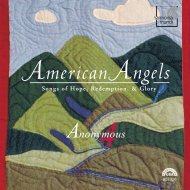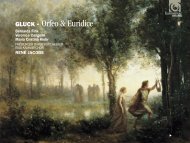NIELSEN THE SYMPHONIES - eClassical
NIELSEN THE SYMPHONIES - eClassical
NIELSEN THE SYMPHONIES - eClassical
Create successful ePaper yourself
Turn your PDF publications into a flip-book with our unique Google optimized e-Paper software.
solved its task. For it is actual life where the others merely portray life…’<br />
The symphony enjoyed a mixed reception. Two and a half months later, how -<br />
ever, when Nielsen again programmed the symphony – this time with a larger<br />
and better orchestra – the leading Danish newspaper Politiken’s influential critic<br />
succumbed totally: ‘For the first time he has been able to create a great work<br />
that reaches up to the heavens while keeping both feet firmly planted on the<br />
ground’. Nielsen kept the symphony in his active repertoire. Outside of Den -<br />
mark he conducted it in Gothenburg and Stockholm (1918), Bremen (1922),<br />
Lon don (1923) and Oslo (1926).<br />
The short orchestral piece Pan and Syrinx was intended for a concert in<br />
Copen hagen on 16th February 1918 but, only three weeks before the concert,<br />
when Nielsen made the programme public, he had yet to compose a single note.<br />
‘It is however quite clear in my mind, so it should be all right, and the copyist<br />
has been warned that he will get it page by page’, Nielsen wrote to his friend<br />
and colleague, the composer Wilhelm Stenhammar on 23rd January.<br />
It was all right – but only barely: Nielsen finished the piece on 6th February.<br />
The inspiration for it had come from reading the Metamorphoses by Ovid, and<br />
he recounted the tale in a foreword to the score: ‘Among the satyrs and nymphs<br />
in the tree-clad hills of Arcadia, the goat-footed Pan, god of the forest, notices<br />
the nymph Syrinx and pursues her with dancing and with bleating praise. She is<br />
frightened by the eager suitor and flees to a forested island. There, when escape<br />
from her pursuer is no longer possible, the compassionate gods transform her<br />
into a reed.’<br />
The reviewers were quick to note that the composer appeared to have chart -<br />
ed a course in the direction of Debussy and the French impressionists. Pan and<br />
Syrinx was often performed in Nielsen’s lifetime, conducted both by him self<br />
and by others.<br />
11

















